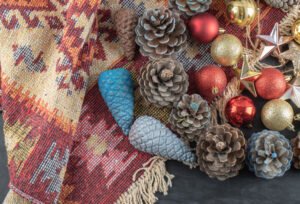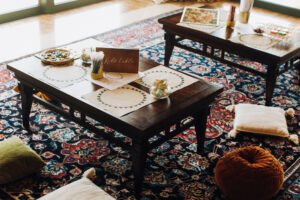Traditional rugs are timeless pieces of art that bring warmth, elegance, and a touch of history to any space. Understanding how to care for and maintain these treasures is essential to preserving their beauty and longevity. This blog will provide a comprehensive guide on the various aspects of traditional rug care, from the making process to the maintenance techniques.
The Art of Traditional Rug Making
The Traditional Rug Making Process
The process of creating a traditional rug is intricate and steeped in history. It involves several key steps:
- Designing: Traditional rug patterns are often inspired by cultural symbols and motifs. Designing a rug involves planning the colors, patterns, and overall layout.
- Selecting Materials: The best materials for making traditional rugs include wool, silk, and cotton. These materials are chosen for their durability and ability to hold dyes.
- Dyeing the Yarn: Using natural dyes in traditional rug making is common. Natural dyes derived from plants, insects, and minerals are used to color the yarn in vibrant hues.
- Weaving: Weaving traditional rugs on a loom requires skill and precision. This step involves interlacing the weft and warp threads to create the rug’s fabric.
- Knotting: Traditional rug knotting methods, such as hand-knotting and hand-tufting, add texture and strength to the rug.
- Finishing: Traditional rug finishing techniques include trimming the pile, washing, and stretching the rug to ensure it lies flat.
Traditional Rug Making Techniques
Several techniques are employed in traditional rug making, each contributing to the rug’s unique character:
- Hand-Knotting: This technique involves tying individual knots onto the warp threads. It’s a labor-intensive process that results in a highly durable and intricate rug.
- Hand-Tufting: Unlike hand-knotting, hand-tufting involves using a tufting gun to push yarn through a fabric backing. It’s faster and often more affordable.
- Weaving: Weaving involves interlacing warp and weft threads on a loom. This technique is common in many traditional rug styles.
Regional Variations in Traditional Rug Making
Traditional rug making varies significantly across different cultures and regions. Some notable examples include:
- Persian Rugs: Known for their intricate designs and high knot density, traditional Persian rug making is a revered craft.
- Turkish Rugs: These rugs often feature bold colors and geometric patterns. Turkish rug making techniques are highly valued for their artistry.
- Navajo Rugs: Traditional Navajo rug weaving is a unique practice among Native American tribes, characterized by distinct patterns and symbolism.
- Indian Rugs: Indian traditional rug techniques often incorporate floral motifs and vibrant colors, reflecting the country’s rich cultural heritage.
- Moroccan Rugs: Making traditional Moroccan rugs involves a combination of weaving and knotting techniques, often resulting in plush, textured rugs.
Caring for Your Traditional Rug
Regular Cleaning and Maintenance
Proper maintenance of traditional rugs involves regular cleaning to prevent dirt and grime buildup:
- Vacuuming: Vacuum your rug regularly to remove dust and dirt. Use a vacuum with a gentle setting to avoid damaging the fibers.
- Spot Cleaning: Address spills and stains immediately. Blot the affected area with a clean, damp cloth and mild detergent. Avoid rubbing, as it can push the stain deeper into the fibers.
- Professional Cleaning: Periodically, have your rug professionally cleaned. Professional cleaners use specialized techniques to deep clean without damaging the rug.
Protecting Your Rug
To ensure the longevity of your traditional rug, take measures to protect it from damage:
- Rug Pads: Use rug pads to prevent slipping and reduce wear. They also provide cushioning and help maintain the rug’s shape.
- Sunlight: Protect your rug from direct sunlight, which can cause fading. Use curtains or blinds to block harsh rays.
- Furniture Placement: Rotate your rug and rearrange furniture periodically to prevent uneven wear and indentations.
Repairing and Restoring
Even with careful maintenance, traditional rugs may require repairs over time:
- Re-fringing: If the fringe of your rug becomes worn, it can be re-fringed to restore its appearance.
- Reweaving: Damaged areas can be rewoven by skilled artisans to match the original design and structure.
- Dye Touch-Up: Faded areas can be redyed to restore the rug’s vibrant colors.
DIY Traditional Rug Weaving
Beginner’s Guide to Traditional Rug Making
For those interested in creating their own traditional rug, here’s a step-by-step guide:
- Choose Your Design: Start with a simple design if you’re a beginner. Traditional rug patterns can be complex, so it’s best to begin with something manageable.
- Gather Materials: Select high-quality materials such as wool or cotton. You’ll also need a loom, which can be purchased or built.
- Dye Your Yarn: If you’re using natural dyes, prepare your dye baths and color the yarn according to your design.
- Set Up the Loom: Warp your loom according to the size of your rug. Ensure the threads are evenly spaced and taut.
- Start Weaving: Begin weaving by interlacing the weft threads through the warp threads. Pay attention to tension and consistency.
- Knotting and Tufting: Use traditional hand-knotting techniques to add texture and detail. If you’re using a tufting gun, ensure even coverage.
- Finish Your Rug: Once weaving is complete, finish the edges and trim the pile. Wash and stretch the rug to achieve the final shape.
DIY Kits and Resources
For those new to traditional rug making, DIY kits can be a great starting point. These kits typically include:
- Loom: A small, portable loom suitable for beginners.
- Yarn: Pre-dyed yarn in various colors.
- Tools: Basic tools needed for weaving and finishing.
- Instructions: Step-by-step guide to making traditional rugs.
Benefits of Traditional Rug Making
Engaging in traditional rug making offers several benefits:
- Creative Outlet: Rug making allows for artistic expression and creativity.
- Mindfulness: The repetitive nature of weaving can be meditative and relaxing.
- Connection to Tradition: Learning traditional techniques connects you to cultural heritage and history.
Conclusion
Traditional rugs are more than just floor coverings; they are pieces of history and art. By understanding the traditional rug making process and techniques, you can appreciate the craftsmanship involved. Proper care and maintenance will ensure your rug remains a cherished part of your home for generations. Whether you’re an owner or an aspiring weaver, traditional rugs offer a rich and rewarding experience.





